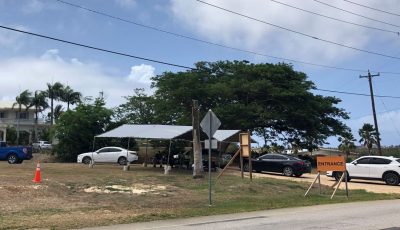Search for Brown Tree Snake enters 2nd phase

Local and off-island experts on the Brown Tree Snake are on the second phase of their search in Dandan. In this photo from the first phase of the search in January, USGS rapid response team coordinator Adam Knox shows one of the traps that they’ve set up for the snake. (Frauleine Villanueva-Dizon)
A second phase of the search for the sighted Brown Tree Snake on Saipan has commenced and will be done until March.
According to wildlife information officer Pete Perez, the second phase started last Monday and will last until March 13.
“We’re starting over again,” Perez said, adding that they will be searching the same area and the same transects in the village of Dandan.
In January, the team was able to cover 398 kilometers in their nightly intensive searches.
This week, 22 people from Hawaii, Guam, and Colorado arrived and a couple more will be coming in, according to Perez.
This Rapid Response Team is composed of experts from U.S. Geological Survey, U.S. Fish and Wildlife, CNMI Department of Lands, and Natural Resources and the Division of Fish and Wildlife.
Perez said 12 to 14 individuals go out every night, but so far, they found nothing. Aside from traps lining the transects cameras have also been set up.
“If we see a snake, then we’ll keep searching and we may expand the area,” Perez said.
However, if no snake is found during the three-week search, they will go down to survey mode.
“If we don’t find anything, then we’ll go to another stage which is monitoring those same transects, we’ll step it down a bit for the next year or so, couple years even,” Perez said.
Perez said they also keep record of the food source in the area such as geckos, mice, rats, and birds.
“We already know there’s a lot of food in the area. If we don’t find the snake, and we start doing surveys and in the next surveys we start find out there’s a lot less food, well maybe we don’t see the snake but there’s that sign that you were wondering about. Its indication that something’s happening, all of a sudden, the food sources drop down,” Perez said.
Perez reminded the public that if they see the snake, kill it immediately if they have the opportunity to do so, otherwise, don’t scare the snake away and call 28-SNAKE for responders to take care of it.
“The most important thing to know is these snakes are not harmful to human beings, they don’t have a poisonous bite, and they’re really easy to kill,” Perez said.
The DFW Facebook page features a video on how to kill a brown tree snake.
Perez also thanked the residents who have been patient in their nighttime searchers.
“Thank you to the people who are putting up with us. We really appreciate their help,” Perez said.



























